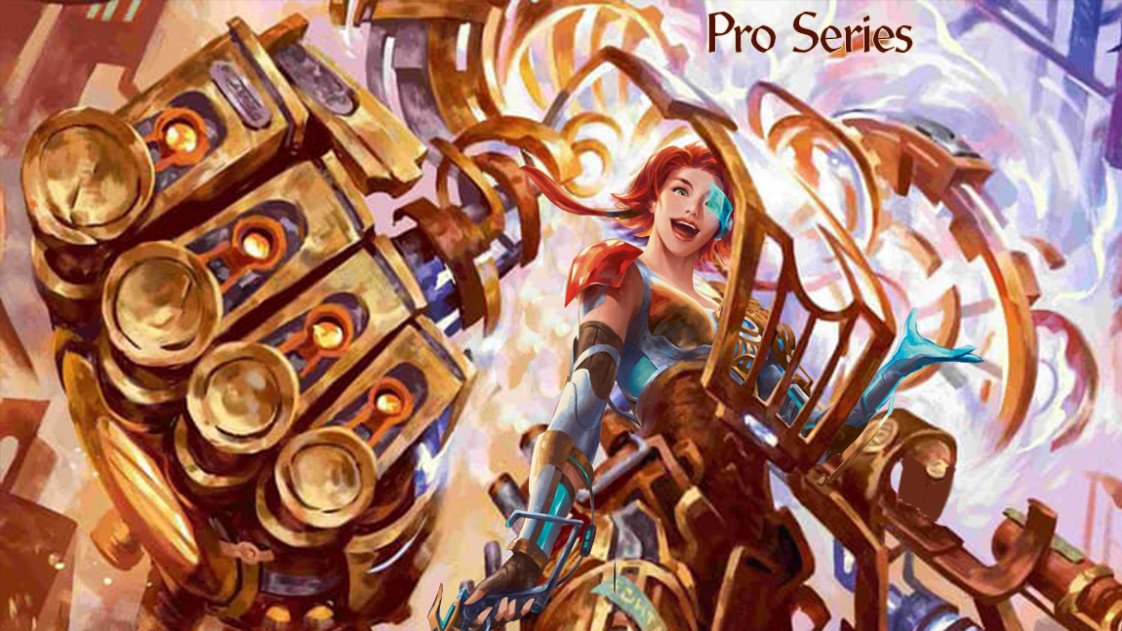If you follow my writing on the Rathe Times, you've seen me allude to my steadfast belief in the viability of a Nitro Mechanoid Dash numerous times. Beginning in the hands of Dash, Inventor Extraordinaire, the Mechanoid deck concept really took off with Bright Lights and the I/O version of our copper-haired heroine. Its conceit is simple: use the combination of boosting, cranking, and topdeck access to find and play out the requisite Hyper Drivers without setting us back so far that even a robot suit can't dig us out. But there were a lot of things to work out along the way.
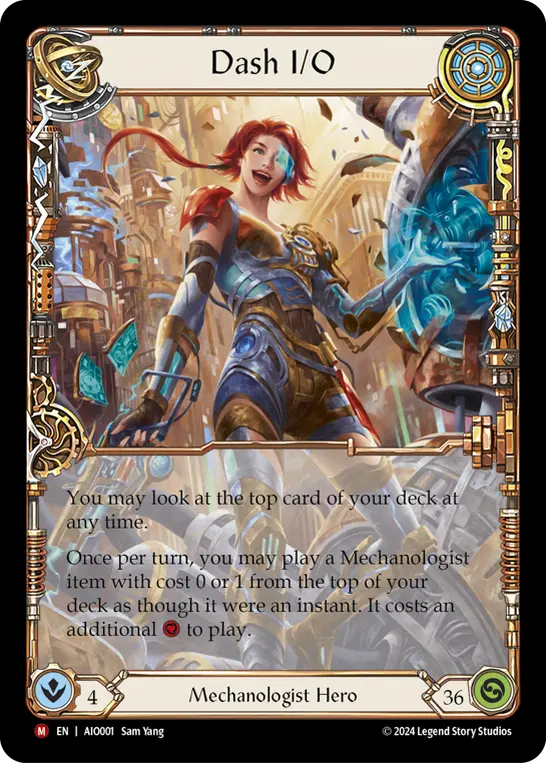

Problem 1: Breaking Boost
It starts, as most things Mechanologist do, with boost. This ability is a double-edged sword, allowing us to exert pressure across wider chain links at the cost of our deck's longevity. Boost has been put to good use by decks like the one Mara Faris brought to US Nationals in Minneapolis in the summer of 2024 (decklist), where a redline build looking to maximize 0-for-4s is enhanced by Dash I/O's instant speed item play to continually threaten unpredictable damage on breakpoint leaks. This was a savvy build that many decks modeled themselves after (though it should be noted that the history of a build like this predates Mara), but it wasn't long before Dash I/O found herself being out-paced within the aggro space, and the risk of fatigue grew as that strategy rose to greater prominence.

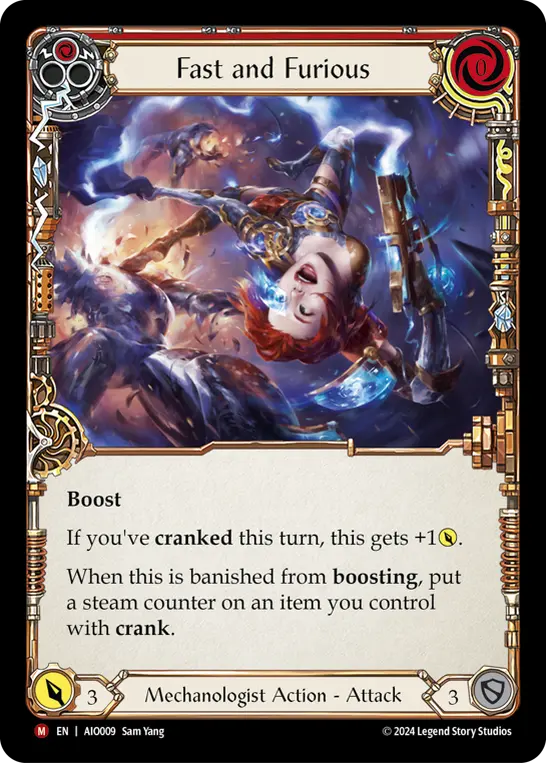
Still, the predominant thought on boost wasn't even binary; it was an 'always on' philosophy that was hard to shake. Much of my time was wasted laboring under the misconception that I should be following the 0-for-4 approach to Mechanology as far as the build would allow me to. You'll find, in my past articles, advice to 'block out after finding your first Driver', which was largely informed by the poor value I was getting playing out a single 4 without boosting, motivated by the primary mission of preserving Hyper Drivers. The deck was fighting itself.
A few months ago, I wrote a piece challenging this 'always on' mentality around boost. I argued that other heroes get 0-for-4s without the 'hidden cost' of a 2nd card burned from the deck. I also noted that, while a 0-for-4 with unconditional go again is generally considered a good card, the real value unique to Mechanologist is that that same card blocks for 3. Put another way, it's versatility the class offers, not aggro value. In this way, we would find ourselves perpetually behind other aggro decks, who push all of their value toward their aggressive posture.
By taking an exclusively aggro approach, we find ourselves perpetually behind other aggro decks, who push all of their value toward their aggressive posture.
Thankfully, the value of boost goes beyond 'go again' in a Dash I/O deck. Because she always knows the top card of your deck, the risk of boosting away a key card is removed - making boost an effective tool for digging through your deck. The benefit of this in any given deck is varied, but in a Mechanoid build, it's fairly direct: we need to find 4 specific cards to build the bot, and boost lets us find them faster. Beyond that, it increases the odds of finding any of the other items we've built into the deck, thereby maximizing Dash I/O's ability and cutting out 0-blocks we'd rather not draw into.
The solution came to me as I was noticing a repeated tendency toward at least 1 turn per game where I'd end a turn with 4+ resources floating: I should be using bigger attacks. Generating resources was a byproduct of the deck's use of Hyper Drivers, and if I was going to be more judicious in my boosting, it made more sense to throw a single 6 than a single 4. (This also solved the classic Mechanologist problem of drawing into an item you aren't planning to play out: useless for blocking, but a valid pitch card.)


I pivoted down away from all but the best 0-cost attacks - Zero to Sixty, Fast and Furious, and 2 T-Bones in the sideboard - and instantly found my deck improving. Data Link became Dive Through Data (a breakpoint), Expedite became MetEx (a breakpoint), and just like that the cards became threatening. And with the typical Construct turn asking for a floating resource alongside the 3 I gain from Hyper Drivers, it's on-brand to pitch for my plays.
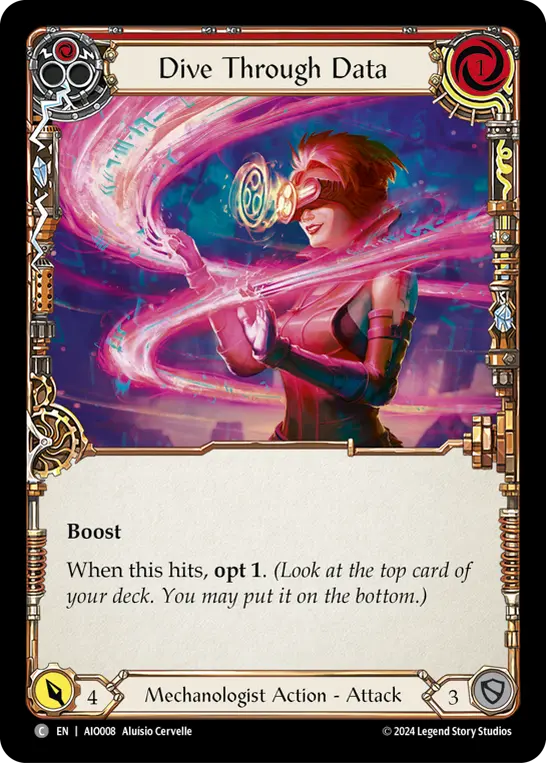

Problem 2: Item Bloat
Dash I/O has a greater reliance on items than any adult Mechanologist - and that can weigh down the flow of your deck fast! Yet just by packing the Mechanoid, we're already committing ourselves to six 1-cost items without crank. This exerts a lot of pressure on the rest of our item selection, and brought me to my second heretical revelation: Teklo Core had to go.

Long considered an uncompromising staple of any Dash deck, this specialization was weighing me down. Without crank, it required a full action point to play out; and the payoff for that was resource generation that 1. I had no control over, and 2. I had no need of. As the Cores returned to the longbox, I committed to rigid guidelines for any items beyond my Hyper Drivers: they had to have crank, and they had to cost 1 or less. There are a host of items that meet those prerequisites, and I've tried many of them. But the ones that have stuck provide consistent value via flexible applications.
Backup Protocol: RED is a toolbox card with several ways to play it - but nearly always, it begins by cranking for an action point. Of course, there's the obvious use of grabbing an attack action to extend your turn; this can be a great way to use extra resources generated by Hyper Drivers. But less obvious is pitching a yellow or blue item on the defensive, trading it in for a block 3.
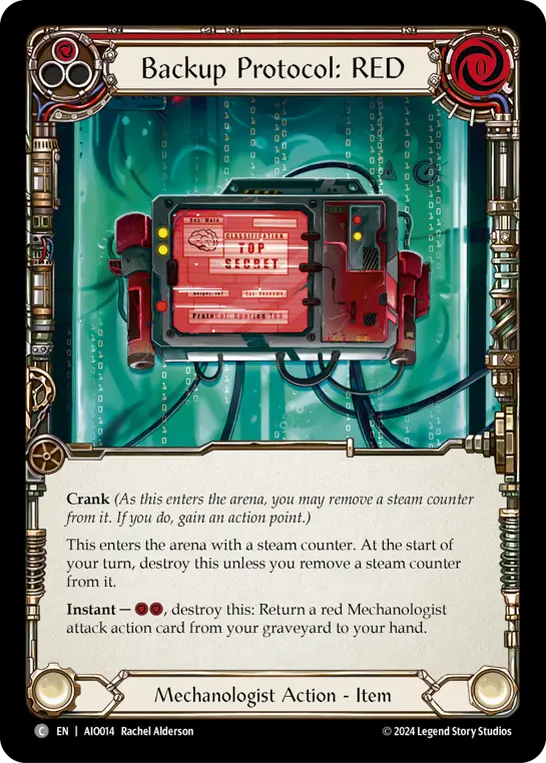
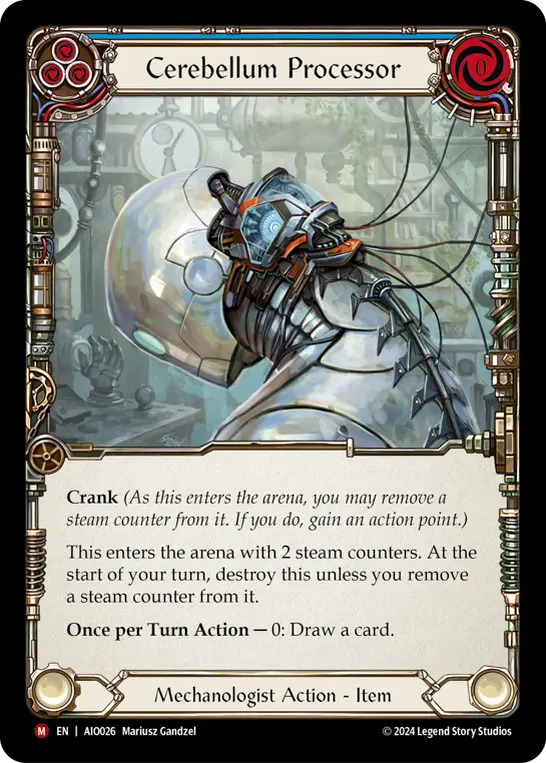
Cerebellum Processor is a great example of a blue item you might want to pitch in that scenario. While many fear the power of Cerebellum's draw, its primary use is, once again, to generate an action point via crank. I'm most likely to trade an action for a card if I spy an essential card on top of my deck - such as Construct Nitro Mechanoid or Spark of Genius - and don't want to boost it away. But blue crank items are top tier cards for this deck, primarily because feeding crank items back into the deck via pitching gives us another chance at those items floating back to the top.
Is it any surprise, then, that Null Time Zone is another core 3-of? There are matchups where this card's text is incredibly relevant, and others where it's only marginally useful - but because it's blue and it cranks, there's no matchup that merits siding it out. I've found some clever uses for Null Time Zone, including calling out Sink Below to cut off defenses or picking a blue I saw them pitch earlier in the game.


Like Teklo Core, Spark of Genius was a card that felt too good to pass up, but was often difficult to get value from. As a Hyper Driver tutor, it required that I boost (spinning down the steam on any Drivers I'd already found), spend 2 resources, and have an empty hand so the drawn card could go into my also-empty arsenal - assuming it was something I wanted in there. But unlike Teklo Core, Spark of Genius proved its value once I reevaluated its purpose in the deck.
If I opened a turn with a boosted attack, I could play Spark of Genius out for free to find any 0-cost crank item; then I could crank it, regaining my action point, and draw a card to continue my turn. While I was no closer to my goal of assembling the Mechanoid, I had pulled a 0-block out of my deck and put useful tech on the board.
Problem 3: What Sideboard?
Whittling down the deck to 60 cards was a long, arduous process. Initially, the deck attempted to include a switchboard package, to drop the Mechanoid when a matchup felt ill-suited for it. But pivoting to a 60-card aggro deck felt bad, like I wasn't playing the deck I wanted to and saddled myself with a worse version of the mainstream build; plus, as I became more experienced with the list, it became clear that I wanted to run Mechanoid into most opponents anyway.
With my newly-freed sideboard slots, I was able to incorporate some tech cards - but what comes out from my core 60 in those instances? Taking out doesn't fit my line of thinking; my core 60 would have to go lower, so that I could add in at the start of each game, not swap. I eventually got down to 53, leaving me 7 cards to add from my sideboard as each game begins.
The task then became: how do I choose which 7? Aside from specific tech - like T-Bone into Ninjas - it felt incredibly arbitrary. And I couldn't afford an arbitrary plan; there were ratios to be maintained! In the end, I settled on 3 items and 4 attacks added with each game.
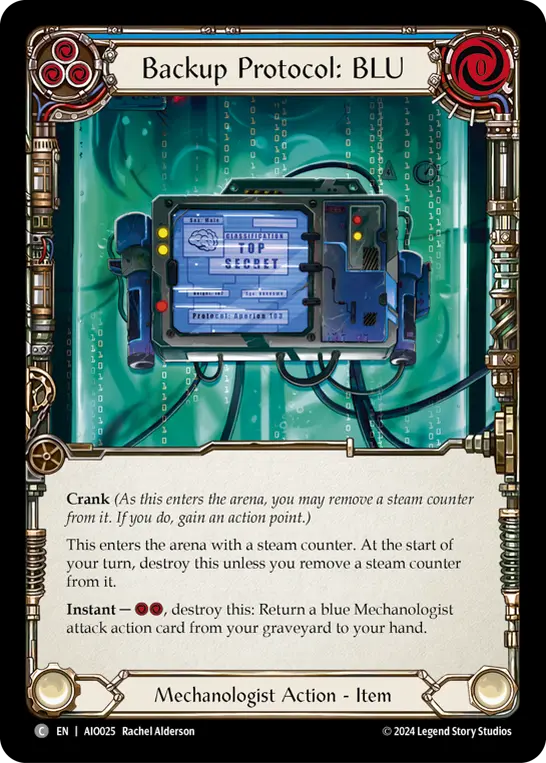
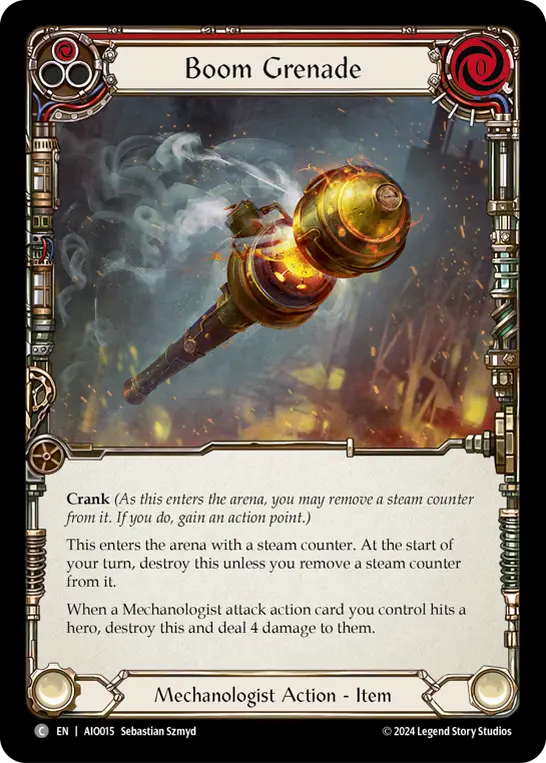
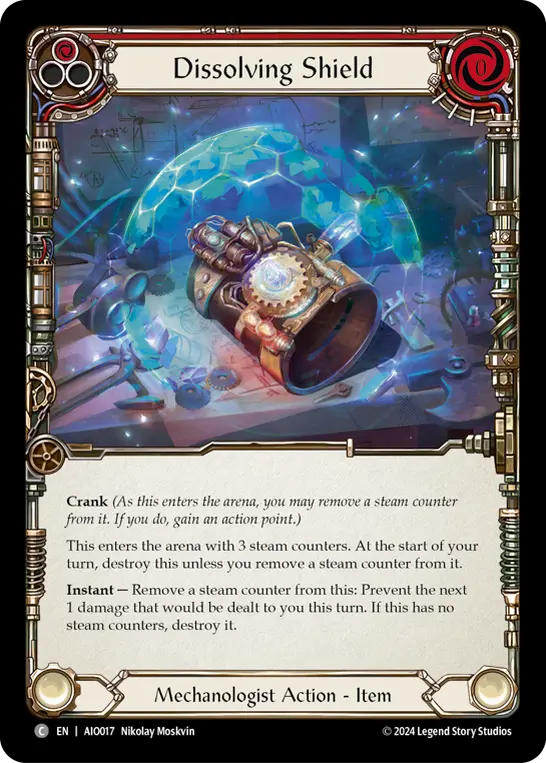

- Backup Protocol: BLU offered the same defensive utility as RED, while adding in the use case of gaining a resource by grabbing a pitch card.
- Boom Grenade (R) allows me to push a more offensive gameplan when pressure is required, and prey on an opponent's preconceived fears.
- Dissolving Shield (R) lends me a defensive topdeck play, and answers pesky daggers and runechants for a turn.
- Security Script pushes my 3-defense attack actions up to 4 defense, allowing them to cover breakpoints like a d-react would.


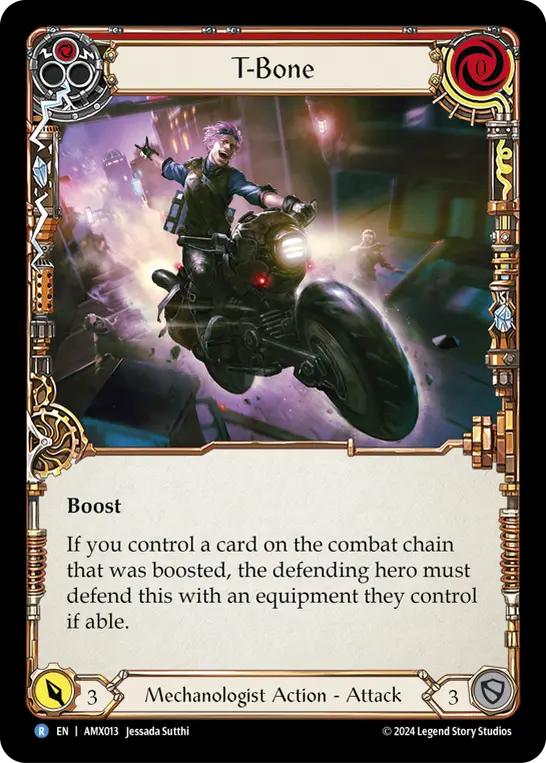

- Over Loop (R) offers recursion when you expect a game to go long - and is usually deemed threatening enough to merit a full block.
- Scrap Harvester (R) is a popper with incredible midgame value as a 2-card 6 that refills steam on a crank item.
- T-Bone (R) has a reputation for breaking irritating equipment, but it's also just a 0-cost 3 for when you expect you'll need to go faster.
- Zoom In (R) acts as an upgraded Dive Through Data, but front-loads its opt on attack, not on hit, guaranteeing you actually get to use it.
I consider the sideboard choices extremely modular, and frequently change them. My FABrary 'Maybes' acts as a quick source of alternatives that I regularly consider - and I expect that section to only grow with High Seas' release. But I strongly recommend taking a similar approach to most deckbuilding - that is, maintaining a 'bench' of cards that might slide in and out of your list between events. Staying agile will keep your regular opponents from learning the ins and outs of your deck, and keep you constantly in that development mindset - key to staying on top of the meta. A perfect 80 shouldn't exist for any deck!
Problem 4: Getting Equipped
Bound by the Mechanoid's prerequisite that all of our attire be Mechanologist, the choices are limited - but we managed to acquire some really decent options recently. Heavy Industry Surveillance adds another 2-block to our kit (just don't block with it a 2nd time!), while Cogwerx Base Legs give us an on-demand action point without destroying itself. We even have Arcane Barrier 3 between Achilles Accelerator and Viziertronic Model i - just keep in mind that once you've constructed the Mechanoid, you're shields down vs. arcane for the rest of the game (though Dissolving Shield can help).

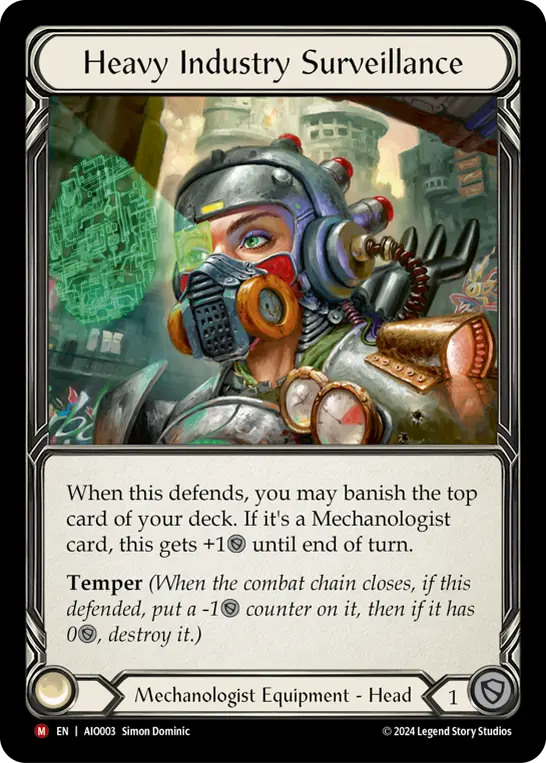
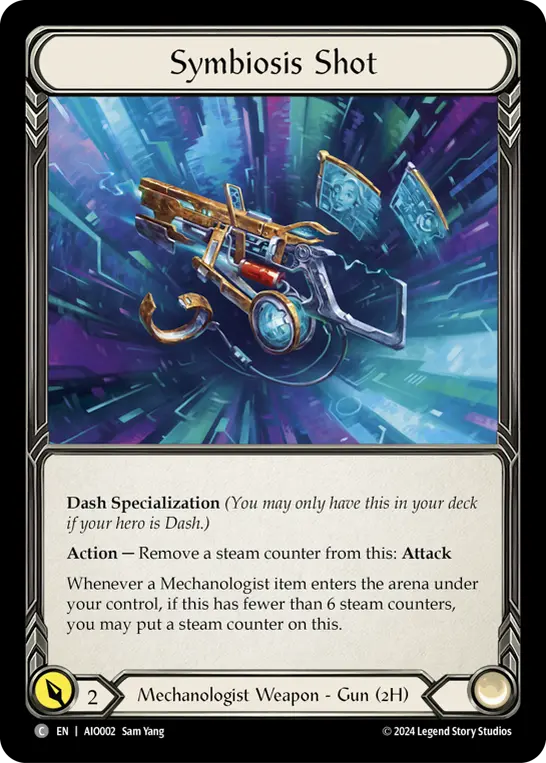
Unfortunately, we're left coming up woefully short on a weapon. Symbiosis Shot is probably the best of the bunch, as it costs only an action point to fire and builds up ammo passively as we put items into play. But this is a deck that seldom lets action points go to waste, and we usually tuck the gun under Mechanoid with 5-6 counters on it. The alternatives are worse: Teklo Plasma Pistol costs a resource to load and only holds 1 shot at a time, while the Hanabi Blaster and Plasma Barrel Shot require wider boosting than we tend to execute. My number one hope for Mechanologists in High Seas is a new weapon that Mechanoid I/O can get better value from.



Similarly, I feel there's a lot of room to reconsider the equipment choices. I'm currently giving an audience to Puffer Jacket, which would let us play a little more aggressively with Hyper Drivers on the table - but it's hard to give up the on-demand resource and 2-card dig that Teklo Foundry Heart represents. (Plus, as one of my earliest legendaries, I have Heart in cold foil.)

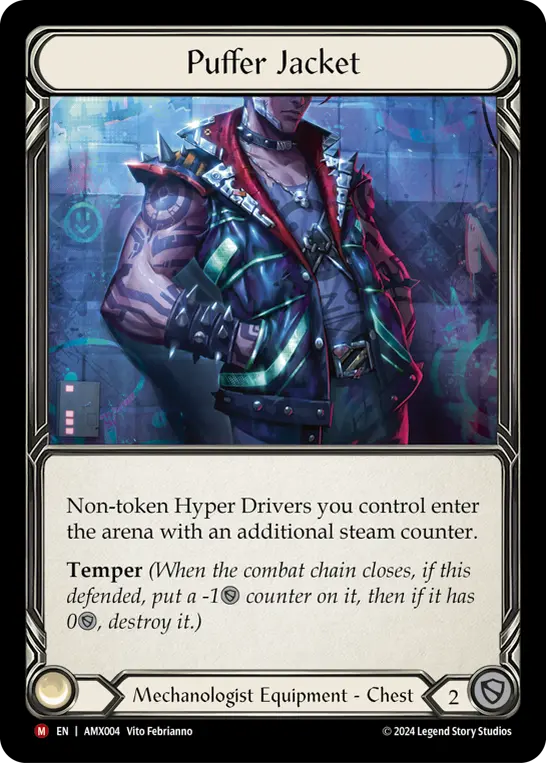
Problem 5: Why Not Maxx?
Finally, let's address the anarchist in the room: Maxx solves a number of these problems for us. He gives Hyper Drivers crank, he actually creates Hyper Drivers, his weapon makes sense in the deck, and Dash kinda feels like she just wants to go fast anyway. Am I forcing this for the theme?
What Dash brings to the Mechanoid gameplan is instant-speed plays that generate action points via crank. While Maxx can keep his turn going, Dash can actually extend it - bringing back just a taste of that Mechanoid/High Octane combo power we used to close games with. She can also play out items on the opponent's turn, which frees her ability for another use on your own turn. When combined with deck-cycling, this can find us our 3 Hyper Drivers and our Mechanoid much faster than Maxx can, even if we assume he can make one of those Drivers himself. Finally, the complete topdeck knowledge means we never risk boosting away our combo pieces - something Maxx players have to learn to live with.
While there are compelling reasons to play Mechanoid if you want to play Maxx, I find it much more debatable playing Maxx if I want to play Mechanoid. At best, they are two valid options - but I'm planting myself firmly on Dash I/O's side of the rail.
The Decklist

Weapons
- Symbiosis Shot (1)
Equipment
- Achilles Accelerator (1)
- Heavy Industry Surveillance (1)
- Cogwerx Base Legs (1)
- Galvanic Bender (1)
- Teklo Foundry Heart (1)
- Viziertronic Model i (1)
Loadout
- Backup Protocol: BLU (Blue) (3)
- Big Bertha (Blue) (3)
- Fast and Furious (Red) (3)
- Boom Grenade (Red) (3)
- Cerebellum Processor (Blue) (3)
- Construct Nitro Mechanoid (Yellow) (3)
- Dive Through Data (Red) (3)
- Heist (Red) (2)
- Crankshaft (Blue) (3)
- Backup Protocol: RED (Red) (3)
- Hyper Driver (Yellow) (3)
- Security Script (Blue) (3)
- Dissolving Shield (Red) (3)
- T-Bone (Red) (2)
- Null Time Zone (Blue) (3)
- Spark of Genius (Yellow) (3)
- Over Loop (Red) (2)
- MetEx (Red) (3)
- Scrap Harvester (Red) (2)
- Rev Up (Red) (3)
- Supercell (Blue) (3)
- Zoom In (Red) (2)
- Throttle (Red) (3)
- Zipper Hit (Red) (3)
- Zero to Sixty (Red) (3)
- Hyper Driver (Red) (3)
At this point, I've articulated why most of these cards are here. But without the strategy, this is just a pile of cards. So let's get into it.
Mechanoid I/O utilizes a pivot gameplan, where we are doing radically different things in different phases of the game. We value our cards and utilize them in very different ways as the game progresses - which plays to the advantages of the Mechanologist class. You can roughly classify the phases as follows:
- Early Pressure / Dig
- Midgame Rope-a-Dope
- The Pivot
- Endgame
How quickly we move from one phase to the next varies, and there are times where you'll have to roll back to a prior phase - this isn't ideal, but it's workable.
Early Pressure / Dig
Whenever possible, we want to take turn 0, for that chance to begin establishing a board and to roll into the true gameplay with an attack in arsenal. I am not at all against attacking on turn 0, as any boost we fire off puts us that much closer to the cards we need to find. It's ideal to hit an item off the top on this opening turn as well; beginning the game with 2 items on board and an attack in arsenal is a dream.
Of course, Hyper Driver is the ideal turn 0 draw. But if you don't have one, you're also doing fine; until that first Driver hits the board, we have no qualms about boosting attacks and going as wide as we can. The Dig goes hand in hand with aggressive pressure, allowing us to unstabilize our opponent as the game begins.
There are two cards we don't want to see on turn 0, and you should consider these pitch cards if you're unfortunate enough to draw them: Construct Nitro Mechanoid, and Supercell. These are Midgame cards, and if you arsenal them thinking you've found one of your combo pieces at this early phase of the game, you're going to find yourself unable to exert pressure. Having an offensive option in arsenal is so important, especially when you draw into an item-heavy hand, to keep some form of momentum and prevent your opponent from simply running you over while you're digging.

I haven't talked about Supercell yet, so let's get it out of the way here: Supercell is amazing when you have 2 or more Drivers, and otherwise it's a pitch card or, in dire straits, a bad block. With 2+ Drivers, Supercell can free you up to boost as much as you want on the way to your Pivot; in some absurd situations, I've played it for 4 and absolutely buried myself in resources. The biggest downfall of the card is that it isn't an item, followed by the fact that it doesn't have go again; it's as clunky as a Hyper Driver played from hand, but it has no value without a Hyper Driver already in play. Don't get me wrong, Supercell is absolutely a gem here, and it's never leaving the deck. But know its value and when to use it.
The best items to find in the Early Pressure / Dig phase of the game are (obviously) Hyper Drivers, Cerebellum Processor, and Null Time Zone. If you're facing a breakpoint aggro deck, Security Script can be a solid come-up also. These cards either help us Dig more effectively or slow down our opponent at a point in the game where we are trying to leverage any and every advantage we can. For attacks, throw any 0- and 1-costs that come along, floating resources for topdeck items. MetEx is especially good at this stage, even if you don't have an item in hand, because it will often convince your opponent to block it completely. We're aiming to keep life parity during this phase, which should be very possible. I'm less keen on throwing 2-cost attacks early, because with a blue pitch you're only left with 1 resource, unable to play Hyper Drivers off the top of the deck; use these to block, planning to retrieve them later via Backup Protocol: RED, or pitch them alongside blues where you can.
I often use my equipment blocks at this phase of the game - you don't want to transform into Mechanoid without getting that value! Remember to only use the head once; the chest you can use twice; and the arms block 1. If there is any risk of having your equipment destroyed, however, simply hold it; we can't risk losing a piece to an Assassin, or making Jarl Vetreiđi's job any easier.
Midgame Rope-a-Dope
Conjuring images of Rock'em Sock'em Robots, the next phase of the game is where we start taking damage. Once we have 1-2 Hyper Drivers in play, you should pivot to a more defensive stance - but also ensure that you're not giving away the tempo entirely.
Hyper Drivers are not sacred, and you can use steam counters off of them - in fact, you should get as much value from them as you can before hitting the Pivot. Watch for Big Bertha and Crankshaft to shop up on your topdeck; boosting one of these away gives you a steam rebate, and can even sustain a Driver that would have hit zero. And once you've boosted once, your Drivers are inactive for the rest of the turn - so feel free to take that turn as wide as you can!
In general, my strategy in this phase is to hold 2 cards to return with an attack of 5-6. This is a great time to find cards like Rev Up, Throttle, and Zipper Hit; Over Loop, Scrap Harvester, and Zoom In (all from the sideboard) shine bright in this phase as well.

Scrap Harvester merits special attention here, because this is when it's at its absolute best. As the only attack in the deck without boost, it wants to be played either as the only attack or as the 2nd (making use of Hyper Driver resources to pay for it). Scrap is a mechanic I'd love to incorporate further, because it sets up Heist so well (more on that card later); but even at 2 copies, Harvester is sufficient to put a threatening crank item in the banished zone while keeping another one around for 1 more turn. Null Time Zone is my number one target for that steam counter, but one more turn of Security Script, Boom Grenade, or even Cerebellum Processor can really change your opponent's plans.
Expect to take damage at this point in the game - you're spending life now to prioritize acquiring the final pieces of your combo. It's okay to drop to a deficit of as much as 20, and a life total with two digits feels very comfortable; the Pivot is just that strong.
The Pivot
The conditions necessary to Construct Nitro Mechanoid are as follows:
- 3 Hyper Drivers on board
- All 4 equipment pieces in tact (plus your gun, obviously)
- 4 resources
But the desirable conditions also include these:
- A boost attack to open the turn, picking up any final value remaining on the Hyper Drivers (without falling below 3, of course)
- An extra resource to pull steam off the Cogwerx Legs, buying us a 2nd action point
- A crank item on top of the deck (before or after your boost), to gain a 3rd action point

That may seem far-fetched, but most of it is on board, or utilizing the same sort of card that our whole deck is made up of. With 12 crank items and 31-33 boost attacks, that's just what we do here. As for the resources, a 1-cost boost attack with a blue pitch is sufficient to start things off:
- Attack with boost, pitching blue (after 3 Drivers kick in, you're floating 5)
- Activate Cogwerx Legs (4 floating)
- Activate Teklo Foundry Heart (5 floating)
- Construct Nitro Mechanoid (1 floating)
- Play a crank item off the top of the deck
- Attack 3 times with the Mechanoid
This turn - from an attack, a blue, and a Mechanoid in hand/arsenal - pushed 23 damage, with 18 of that presented as 6s with overpower.
Endgame
From here, many games are irrevocably in our hands. The tempo has been permanently seizes, as we go into the next turn with 5 armor ready to block with before we even touch our hand. Throw all the attacks you can, boosting hard before finishing with a punch from the Mechanoid.
Wherever possible, look for opportunities to pick up an extra action and double down on those Mechanoid swings. We haven't transformed, you'll note; we still have Dash I/O's topdeck access, and can instant-speed items into play and crank them for extra actions.
It's at this point that we want to be playing out Heist. This 5 attack is now threatening "on hit, gain an action point and go again" by virtue of pulling back a crank item from your banished zone. It's a must-block, in other words, and helps to keep momentum firmly in your hands.
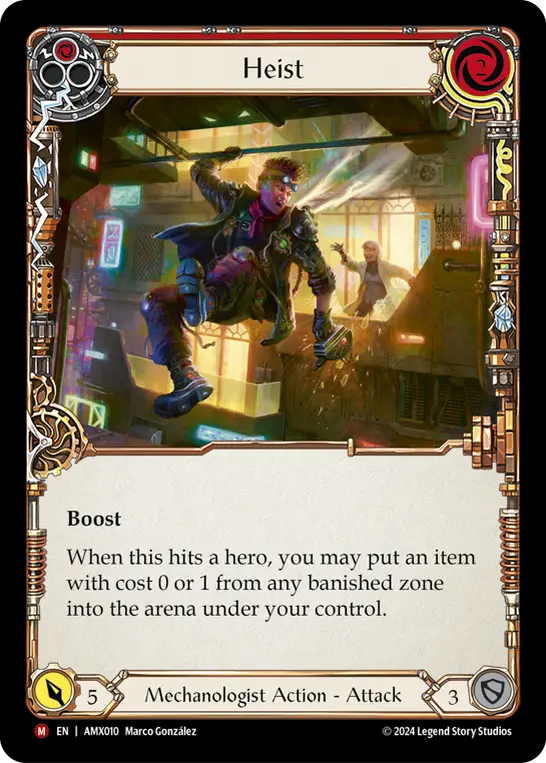
A few notes of caution that can derail your Endgame:
- The Mechanoid is simultaneously an equipment, a weapon, and an item. As such, we are vulnerable to all the things that target those game elements. Our leading concern is equipment hate - Jarl Vetreiđi and Shred at the forefront. We can get frozen out by a well-timed Kabuto of Imperial Authority, and debuffed by Frailty. Item hate is rare, but does exist; if you're repeatedly playing this list into the same opponents, watch for them to add Smashing Good Time, Imperial Warhorn, Argh... Smash!, or even Smash and Grab to qualifying lists.




- I noted before that constructing the Mechanoid means we're defenseless to arcane damage. With no arcane barrier available, we have to be confident when we Pivot into a Wizard or Runeblade. The best defense here is a healthy life cushion and relentless aggro - but we can also utilize Dissolving Shield to skim off some damage, and Null Time Zone to prevent combo pieces from getting played out. A Null Time Zone on Blazing Aether is a great insurance policy against Kano!
- Depending on how long it took you to Pivot, you may be getting towards the end of your deck. While a deck-out isn't entirely game over for the Mechanoid - which can continue to throw fists until its 8 components have been banished - it's one of our existing vulnerabilities nonetheless. Track the state of your deck as you approach that empty tank, and recognize when you're at do-or-die; you don't want to leave anything on the table when you collapse!
Battery Backup
There will be games where you won't be able to Pivot, and those games will be won or lost depending on how quickly you recognize that. We are at our most vulnerable during the Midgame Rope-a-Dope, so our goal is to make that period as short as possible, either moving forward to the Pivot or reversing course and applying Pressure again.
Thankfully, the Hyper Drivers we've assembled working toward the Pivot can pump up our Pressure game as well. Use them to fuel wide turns that chain 6s and 5s; a blue pitch with two Drivers on board can pay for three 6s, if you use the Teklo Foundry Heart as well. And with the Mechanoid being such a prominent part of your deck, it should take a hot second for your opponent to realize you've completely changed postures and re-calibrate their approach to the matchup.
Even if you're still going after the Pivot turn, don't be afraid to seize on an opportunity like that. An 18-damage turn is the sort of thing we want to do in this deck, regardless of what phase we're in; even if the play costs you a Driver, take the momentum and replace it later!
Matchups
While the sideboard is intentionally pretty simple, there are a few matchup-specific considerations that merit discussion. The right item for any given matchup isn't always obvious, and there are a few matchups that merit going above 60.

For the moment, Nuu is still a part of the meta - and as the preeminent active mill deck, she threatens our class' vulnerability to decking out directly. Boom Grenade and Dissolving Shield are great items in this matchup - the former helps us pressure her to block, while the latter catches daggers and acts as a pseudo-react to their climbing. I'd also run Over Loop, Scrap Harvester, T-Bone, and Zoom In, making a total of 67 cards in deck.
With all that said, this is a decent matchup for us, perhaps even favorable, so long as we keep on the pressure and go fast. Our knowledge of topdeck de-fangs many of Nuu's stealth attacks, which rely on catching us off-guard with random banishes; and as the last remaining Mystic, Nuu is the one hero still devastated by Null Time Zone's calling Inner Chi.

Jarl Vetreiđi represents all Guardians here, but is by far the most concerning. The Guardian meta of today is often fatigue-based, and as I've said before, fatigue is an inherent risk of playing Mechanologist. But the Elemental Guardian also threatens to wreck our equipment if we don't play cautiously. In this matchup, I put myself on a timer for the Mechanoid, assuming I have 4-5 turns tops to get everything assembled. That's a very doable timetable - I often Mechanoid on 3 or 4 - but it's made more difficult by the extra cards we bring into this matchup. Backup Protocol: BLU, Security Script, Over Loop, Scrap Harvester, T-Bone, and Zoom In bring us to 67 again.
We win this game with pressure and speed. Take any opportunity to push damage when you find an opening in the Guardian's steady defenses. That said, the Pivot is our most explosive turn, and we need that damage output too - so don't give away your Drivers unless you have to. If those 5 turns have passed and you haven't found it, buckle up for a long game that you may have to end with a very late Mechanoid pushing a 20+ damage turn - though the odds of you getting there get long.

The sole remaining Illusionist in CC is the one we're happiest to face. With Scrap Harvesters in, we have 8 phantasm poppers, making Prism work to get Heralds across the board cleanly. (Yes, we have no 7s, but repeatedly threatening to pop eventually gets through - she can't always have it.) Null Time Zone is a super clean way to deal with Arc Light Sentinel loops, or just prevent Herald or Erudition from getting played. We even have legitimate action points - not just go again - to give us the space to attack spectras (these are great targets for Symbiosis Shot).
In this matchup, I like Dissolving Shield, Scrap Harvester, and Zoom In.
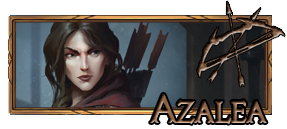
Azalea presents one very concerning issue for Mechanoid I/O: Red in the Ledger is incredibly oppressive and dominate can make it hard to block. (Pray they aren't on Sandscour!) My advice to block with equipment early doesn't apply here; we need to save any equipment blocks for dominated Reds. If we manage to Mechanoid, we've sealed the game - they can't weather that kind of aggression, and our Mechanoid blocks render dominate all but obsolete.
Run Boom Grenade, Scrap Harvester, and T-Bone.
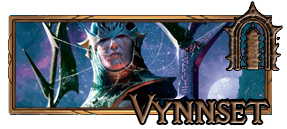
The most interesting thing about the Vynnset matchup is how similar our strategies are. Vynnset also has incredibly strong aggro turns with setup turns and hurt-me-now, hurt-you-later exchanges. Try to stay ahead of their life total early, so that you have more cushion during the Midgame Rope-a-Dope; you'll need to be exceedingly careful with timing your Pivot due to the amount of arcane damage Vynnset can send at you in a single runegate attack. While it's likely you and Vynnset will remain at life parity throughout the game - usually we're clawing back from a 10-20 point deficit with our Mechanoid - you absolutely have to end her fast once you've lost your arcane barrier.
Dissolving Shield is a major difference-maker in this matchup, especially if you can get one on board alongside your Mechanoid. Beyond that, go for damage, with Scrap Harvester and Zoom In.

Let Kano represent the Wizard class here - even though there are games where Kano will just do Kano things, and there's little to be said about that. We're well equipped with Arcane Barrier 3 to slow the damage we take in the pre-Mechanoid phase of the game; but once we've Pivoted, we need to end the game ASAP. Thanks to Kano's 30 life, we shouldn't have a hard time doing that; and if you manage a Null Time Zone during this stage of the game, calling Blazing Aether can be a huge relief - as long as you remember two important nuances here. First, that they can pop off in response to the Null Time Zone, so it's best to play it out prior to the Mechanoid, instead of relying on it to save us afterwards. Second - and this is key - Null Time Zone only prevents a card being played from hand - so Blazing off the top will still get us. You may, instead, choose to call a blue you believe they have in hand, and limit what they can pitch. With Kano, there's always so much we have to allow fate to decide!
The cards for this matchup are Dissolving Shield, Scrap Harvester, and Zoom In.
The Development Roadmap
While a part of me wanted to hold off on publishing this piece until after High Seas injected a new pool of cards that are likely to be relevant to our list, ultimately I felt Mechanoid I/O was at a place where its current build merited acknowledgement. There are always improvements to be made, but the pieces we received in Dash's Armory Deck and The Hunted's expansion slot truly brought the list out of beta, and I'm comfortable calling this ready for release.
Here's what I'll be watching for in High Seas:
- A Mechanologist weapon made for off turns. I'd love a 2-cost 4 - it doesn't need to do anything more than that - or something that adds to the value of playing an item. For that matter, I dream of a Teklo Plasma Pistol for 4 that costs 3 to load. Essentially, when I give my hand away to blocking, I'd like to have a weapon to get me to the next turn.
- A wider array of crank items. It may seem heretical to say, but Cerebellum Processor could be a sideboard card if I had another strong blue crank-able item. Meanwhile, every item in my sideboard could be reconsidered, starting with Backup Protocol: BLU.
- Galvanize looks to be returning, and I'll be honest, I'd gladly give up many of my crank items for +2 on defense. While I haven't incorporated galvanize at all in my current list, a few sit in my Maybes, and any synergy could push me to explore them more thoroughly.
- Big damage is one of the unique features of this deck, so I'm excited that it seems to be a theme in High Seas as well. I don't know that we'll gave any access to cogs at all, but I could go all in on them for the sake of cards like Palantir Aeronought and Sky Skimmer.
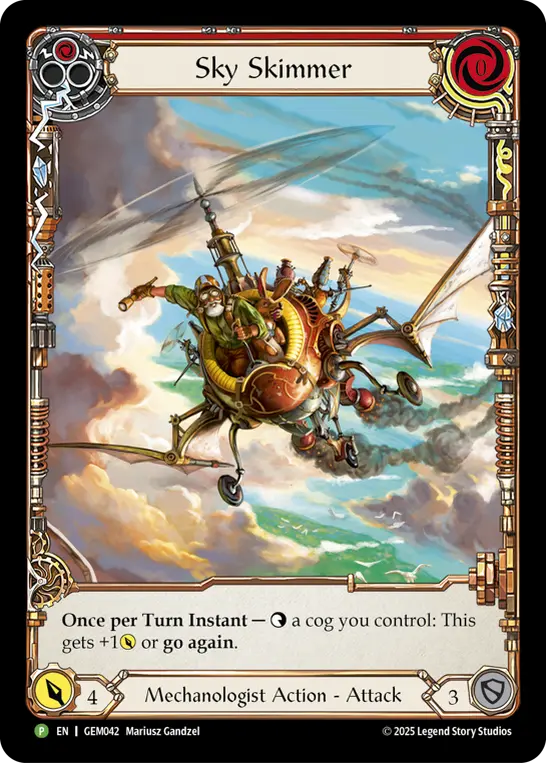

As for the competitive prospects of the Mechanoid? I truly believe this is a deck that could find a foothold under a few conditions:
- Jarl Vetreiði can't be on top. Any meta that prominently features Guardian is going to be difficult for a Mechanologist, and while we have better game into fatigue than boost-focused builds, we're still not comfortable with it. More importantly, we're incredibly vulnerable to equipment destruction in particular. For this reason, while I'd love to be repping Mechanoid I/O in a Pro Quest alongside this article's release, I can't recommend this list for top tier play in this exact moment.
- It has to be an off-meta pick. Obviously, my taking this list public here on the Rathe Times is a strike against that, but I'm under no delusions to believe Mechanoid I/O will become the predominant build for Dash I/O just because I wrote this. The bigger risk is that your locals get used to you running it, and begin to sideboard hate cards. If you see anti-item tech beginning to creep into your opponents' decklists, you may have worn out your welcome. Let Mechanoid I/O recharge for a few weeks before trying to take an event with it again.
- We need a better weapon. If there's one thing that's holding us back, it's efficiency issues - and while Symbiosis Shot is a very efficient value engine that gives a nice rebate for the nuisance of playing an item, we're never getting that full value back from it. Thankfully, High Seas has already committed to giving each hero 2 weapons to choose from, doubling our odds that at least 1 will be the improvement we seek.
If you decide to give Mechanoid I/O a run, let me know how it goes for you! I'm happy to discuss the finer points of the list, or even take constructive feedback on what you think is wrong with it (you can find me on Discord as saturnflight - Rathe Times, or shout us out on our socials). Stay tuned in the aftermath of High Seas' full set reveal, when I'll return with a brief Pro Series update to share what I've incorporated into the list.

